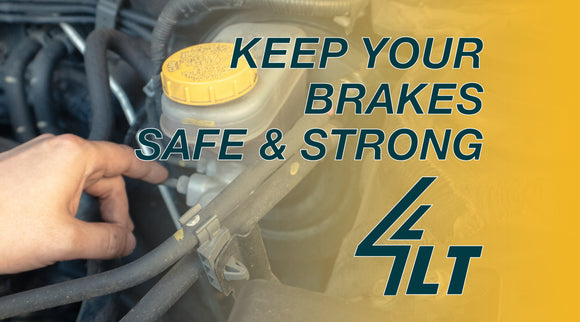
Safety First: Inspecting & Maintaining Brake Lines
Safety First: Inspecting and Maintaining Brake Lines for Optimal Performance
Why brake line maintenance matters
Your brakes are only as strong as the lines that feed them. Corroded, kinked, or leaking lines mean longer stopping distances—and real safety risk. The good news: simple, regular inspections and a few protective habits keep your system solid and your pedal feel consistent.
Quick inspection cadence
Every oil change (5,000–7,500 miles): Visual check of lines, fittings, and clips.
Before/after winter or salty-road seasons: Deep look at exposed hard lines and frame runs.
Any time pedal feel changes: Inspect immediately (soft pedal, extra travel, or spongy feel).
If you see active fluid leaks, severe rust flaking, or damp line sections: park it and address it before driving.
Inspection checklist (front-to-back)
Work on a cool vehicle, chock wheels, and use jack stands on solid ground. Good lighting helps.
Master cylinder / proportioning area
- Look for dampness around the master, distribution block, and nearby fittings.
Frame rails and underbody runs
- Check for rust scale, pitting, or bubbling under coatings.
- Watch for abrasion where a line rubs a bracket or body panel.
Wheel wells & flex hose transitions
- Inspect where hard lines meet flex hoses. Look for cracked hoses, rusty unions, or loose clips.
Over the rear axle & fuel tank
- These are corrosion hot spots. Use a mirror to see hidden sections.
Fittings and unions
- Verify flats are not rounded. No weeping, no greenish/whitish crust.
Routing & clips
- Lines should be secure, not vibrating. Replace missing or brittle clips.
Kinks and prior repairs
- Any flattened bends or questionable unions? Plan a proper re-run and re-flare.
Fluid check
- Reservoir level and color. Dark fluid or debris suggests moisture/age—plan a flush.
Pass/Fail rule: If you find leaks, heavy scale, deep pitting, kinks, crushed sections, or hacked repairs—that line is done. Replace; don’t gamble.
Common failure points to watch
Road-salt zones: Northern climates, coastal areas, and anywhere brine is used.
Underbody traps: Dirt and moisture collect behind shields and along frame steps.
Clip pinch points: Old clips can bite through coatings over time.
Improper bends: Tight, un-supported bends fatigue and crack.
Maintenance that extends line life
Keep it clean
- Rinse the underbody during and after winter. Focus on frame rails, over-axle runs, and line clusters.
Protect contact points
- Replace tired clips and add isolators where lines touch metal. Avoid zip-ties that cut into coatings.
Choose the right material
- Steel/PVF: OEM-style, durable, budget-friendly; needs vigilance in salt states.
- Copper-Nickel (CuNiNi): Excellent corrosion resistance, easy to bend/flare—great for long-term builds.
- Stainless: Strong and corrosion-resistant; verify compatible fittings and correct flares.
Quality fittings & proper flares
- Match thread, seat type, and flare standard (double/inverted vs. ISO/bubble). Use a calibrated flaring tool.
Fluid health
- Flush every 2 years (or per manual). Moisture lowers boiling point and accelerates internal corrosion.
Step-by-step: replace a damaged hard line (overview)
If brakes are your daily-driver lifeline and you’re unsure at any step, have a qualified pro do the work.
Plan the run
Match original routing. Measure length with a string and add a small margin. Note flare style and fitting sizes.
Select material & tools
Choose steel/PVF, CuNiNi, or stainless. Gather tube bender, cutter, deburring tool, flaring kit, line wrenches, and new clips.
Remove the old line
Catch fluid, cap open ports, and avoid twisting hoses. Penetrating oil helps on older unions.
Cut, deburr, and flare
Square cuts only. Deburr inside/out. Create the correct flare (double/inverted or ISO) per vehicle spec.
Bend to fit
Make smooth, supported bends. Avoid kinks—use a proper bender, not pliers.
Install and secure
Start fittings by hand to prevent cross-threading. Torque snugly—don’t over-muscle. Add or replace clips/isolators.
Bleed the system
Bleed in the correct sequence (often RR→LR→RF→LF; verify for your vehicle). Maintain reservoir level.
Leak test & road test
With the engine off, hold firm pedal pressure for 30 seconds—no drop. Inspect for seepage. Short, low-speed test and re-check.
Visual cues that require immediate action
Fresh or dried fluid trails along a line or near a fitting
Soft/spongy pedal, increasing pedal travel, or pulling under braking
Rust flaking you can lift with a pick
Bulges/kinks/flat spots on a line
Cracked flex hoses or wet hose-to-line unions
If any of the above appear, do not drive until inspected and corrected.
Pro tips by material
Steel/PVF: After install, touch up exposed areas with corrosion-resistant coating. Keep clips fresh.
Copper-Nickel: Great for DIY—flares cleanly and bends smoothly. Still use clips/isolators to prevent fretting.
Stainless: Use high-quality tools; stainless is less forgiving. Confirm flare compatibility with your fittings.
Torque, threads, and flare compatibility (quick guide)
Never mix bubble (ISO) and double (inverted) flare components.
Match thread pitch and seat angle to vehicle spec. When in doubt, reference the service manual or verified fitting guide.
Snug, then check: you’re sealing on the flare, not by overtightening the threads.
Fluid and bleeding basics
Use the DOT grade specified for your vehicle (commonly DOT 3 or DOT 4). Don’t mix silicone DOT 5 with glycol-based fluids.
Keep the reservoir topped during bleeding; don’t aerate the system.
If ABS is involved, some vehicles require a scan tool activation for the modulator during service.
When to call a pro
Severe underbody corrosion near structural points
Unclear flare/fitting standards or seized unions throughout the system
Repeated soft pedal after correct bleeding
Any uncertainty about safety-critical routing or ABS procedures
Shop the essentials at 4LifetimeLines
Brake Line Coils (Steel/PVF, Copper-Nickel, Stainless)
Fittings & Unions (ISO/Bubble, Inverted/Double)
Flaring & Bending Tools (pro-grade, clean repeatable flares)
Clips, Brackets (secure, vibration-free routing)
Build it once, build it right. Quality lines, correct flares, secure routing, and fresh fluid—those four things keep braking consistent and safe.
